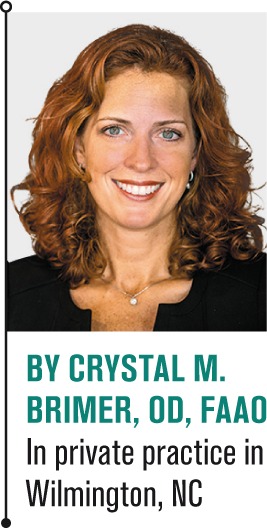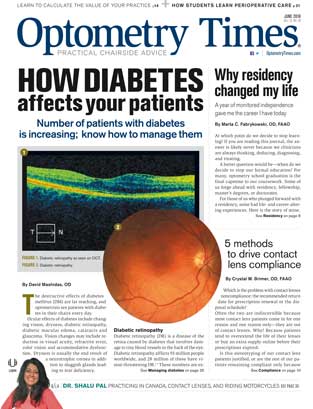5 methods to drive contact lens compliance
Every patient responds differently to contact lens best practices. Here are five methods to help get patients to comply with their contact lens prescription.


Which is the problem with contact lenses noncompliance: the recommended return date for prescription renewal or the disposal schedule?
Often the two are indiscernible because most contact lens patients come in for one reason and one reason only-they are out of contact lenses. Why? Because patients tend to overextend the life of their lenses or managed to buy an extra supply online before their prescriptions expired.
Is this stereotyping of our contact lens patients justified, or are the rest of our patients not letting us down only because we are not asking them to be accountable for something? We have compliant glaucoma and dry eye patients, and we ask a great deal of them. The difference is that these patients are motivated by pain or the threat of blindness.
When I was younger, my ratio of “imprudence” was higher, and my aversion to risk was lower. Perhaps that is why my multifocal contact lens wearers behave better, but it could also be because they are less tolerant of visual acuity changes when wearing contact lenses.
Aside from the know-it-all attitude, there is also the deterrent of cost. Somewhere along the way, ODs became perceived as “bad guys” who needlessly require an exam and hold patients’ contact lens prescriptions hostage for no reason.
Related: Work with patients to combat contact lens obsolescence
As much disdain as ODs have for online contact lens retailers, cost is a driving force in some patients’ contact lens abuse scenarios. Online retailers deliver the perception that they are cheaper and are on the patient’s side. Perhaps ODs’ gripes should not be aimed at just the online retailer. Instead, it is up to each OD to change each patient’s perception and mindset.
Here are five methods to help drive contact lens compliance.
1. Discipline
The discipline method relies on the policies you put in place. What is your response when you receive a request for contact lens samples and the patient is overdue for an exam? If you simply require the patient to schedule the appointment, it could lead to a no-show and added frustration.
What do you do when you get a fax requesting prescription verification?
What about when patients want to buy lenses from you, but the supply would overextend the time they have left before exam time? Do you have policies in place that are specific to extended wear patients?
If you want your staff to respond consistently to these challenges, set your policies accordingly.
2. Incentive
What incentive do you offer to entice the patient? Most of us offer a discount in addition to rebates when patients buy an annual supply. Some offices will also offer a free pair of sunglasses with the purchase of an annual supply, while others offer a discount in their optical.
We offer $75 off glasses when an annual supply of contact lenses is purchased. It seems to make a bigger impression to patients than a percentage off. Other simple offers could include free large bottles of lens care solution, an extra trial pair of lenses, or a Starbucks gift card.
3. Education
This method consists of time, scripting, and equipment. Use your anterior segment camera to show patients changes that have already taken place, such as pannus, neovascularization, and corneal or conjunctival staining.
I use my 5M corneal topographer to dive deeper. I show patients a quantitative redness score, tear film dynamic to show them the debris in their tears, interferometry to show them a lack of oil in the tear film, and the non-invasive tear break-up to show its impact on their vision and ocular surface.
At this point, patients are usually convinced that there are consequences to contact lens wear. This technique has helped our practice keep 93 percent of our contact lens patients in daily disposables.
Contact lens abuse could lead to many problems. Patients could wake up with an ulcer that scars their vision, and it could take their eyesight.
ODs must emphasize and set the expectation that patients’ yearly exam is not about holding their prescriptions hostage. It is about avoiding potential health risks that may accompany contact lens wear.
The more we discuss and show patients their ocular surfaces and the changes induced by contact lens wear, the more we can chisel away at preconceived notions.
It is always important to discuss cost. Talk about the health of the patient’s eye, then correlate the difference in cost to a patient’s expense of less importance. A good example might be comparing their contact lens expenses to a Big Mac once a week, Starbucks twice a week, a nice bottle of wine per month, or a good pair of shoes per year.
Related: Upgrade your patients to new technology
Patients spend money on something frivolous every month. Find out what that is and make a comparison.
4. Use the tools you have
You can utilize your electronic medical records (EMR) to send a reminder to patients to buy contact lenses when they should be running out or when it is time for an exam. Alert patients ahead of time that they will receive these notifications, as well as an appointment for one year out. Set the expectation with patients that they will be discarding lenses according to the schedule you provide.
You can also create a prescription notepad with checkboxes to tell the patient how many hours to wear their contact lenses, when to throw them away, what solution to use, and when to return. Ask the patient to sign it as a commitment, and keep a signed copy scanned into his chart.
5. Know what works
Methods used may be different for each patient, and therein lies the difficulty. In a busy practice, we have to put policies in place, pick an exam room method, and run with it.
There are always reasons to make exceptions. Create an office policy and an exam room method to limit frustrations. Customize your methods when you are able to and be flexible when it seems like the right thing to do.
The more you educate your patients, the better they understand and the more compliant they become.

Newsletter
Want more insights like this? Subscribe to Optometry Times and get clinical pearls and practice tips delivered straight to your inbox.